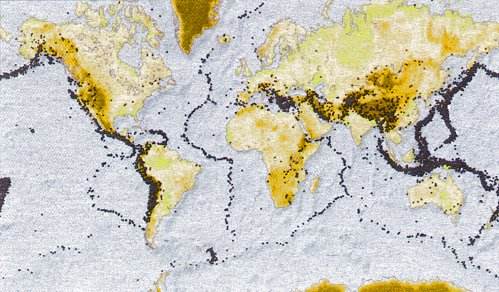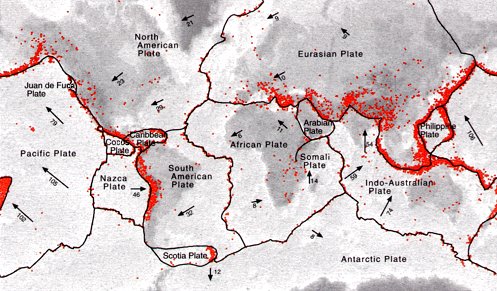IRIS Educational Materials
| Education & Outreach Series | No. 2 |
| Why Do Earthquakes Happen? | |
|
You probably associate earthquakes with destruction caused by falling buildings or by the creation of tidal waves. While earthquakes may be associated with destruction in the time frame of human activity, in the evolution of the Earth they signal the geological forces that build our mountains and create our oceans. In many ways, earthquakes are one of nature’s reminders that we are living on the thin outer crust of a planet whose interior is still cooling. Earthquakes happen when parts of Earth’s crust move. Big earthquakes occur with movement of about a meter or two. Small earthquakes happen with movements of millimeters. On the maps below, each dot marks the locations of a magnitude
4 or larger earthquake. The earthquakes were recorded over a five year
time period.
| |
|
Earth’s outer surface in broken into what geologists call plates. Earthquakes occur when plates move under, over, or slide past each other. As you can see on the map below, most earthquakes occur along the edges of the large plates that make up Earth’s crust. The arrows on the map indicate how fast the plates are moving in millimeters per year - about as fast as your fingernails grow.
|
|
IRIS is a university research consortium dedicated to monitoring the Earth and exploring its interior through the collection and distribution of geophysical data. IRIS programs contribute to scholarly research, education, earthquake hazard mitigation, and the verification of the Comprehensive Test Ban Treaty. Support for IRIS comes from the National Science Foundation, other federal agencies, universities, and private foundations. The seismic monitor was developed by the IRIS Consortium, US Geological Survey, University of Colorado, and Reel Illusions Multimedia, Inc. 1200 New York Ave., NW #800 |
|
| This educational material is reproduced with permission from the IRIS Consortium. | |
|
To obtain a copy of " Education & Outreach Series No. 2"
in Adobe PDF format, To request preprinted copies of any or all of the Education & Outreach Series, please send your request to info@iris.edu (please include the handout volume number and quantity needed for each). |
|
|
updated 02/10/14 |
|





